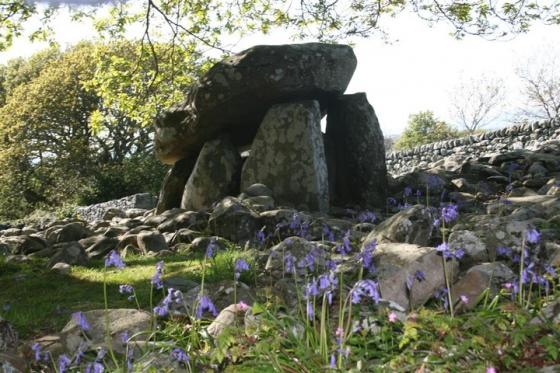
The view from above Bwlch Cau to the north that few of the visitors to Pen y Gadair seem to seek out, just me and some sheep on an otherwise busy day. Looking towards Craig Cwm Amarch, with the softer peaks of the Tarrenau hills beyond.

The view from above Bwlch Cau to the north that few of the visitors to Pen y Gadair seem to seek out, just me and some sheep on an otherwise busy day. Looking towards Craig Cwm Amarch, with the softer peaks of the Tarrenau hills beyond.

Looking down on the lake from Craig Cwm Amarch to the west.

Llyn Cau in its mountain cradle, from the path up to Craig Lwyd.

A contrast to my previous visit in filthy November weather, the quartz boulder in Spring splendour with bluebells.

This extremely prominent quartz boulder is located above Nant Cadair, close to the Minffordd path. If Dr Toby Driver’s speculation is correct and this path is an ancient route up to the lake, this quartz boulder must have been well-known to the passing visitors.

Llyn Cau seen through mist from Craig Lwyd, on the descent from a climb of Craig Cwm Amarch in filthy conditions. If this was a place of pilgrimage, it certainly has the ability to throw in some seriously arduous conditions!
From Dr Toby Driver, RCAHMW, 9th October 2018:
There is a high likelihood that the lake was a place of sacred importance in the Iron Age given the find of a hoard of La Tene Late Iron Age metalwork (NPRN 419531) a kilometre to the south-east on the mountain path up to the lake. However, further archaeological investigation of the landscape environs of the lake are required to place it in a more robust archaeological context.
The horde was found below Llyn Cau in a cavity below a large boulder protruding from the mountainside;
Field visit by Toby Driver, RCAHMW, 11th December 2013. The find spot is marked by a prominent glacial boulder, naturally fallen into its present position and propped up on massive upright stones so as to resemble an artificial ‘burial chamber’. Beneath the boulder is a dark, nartually formed ‘chamber’ which may have attracted Iron Age people to use the site as a place of deposition. The find spot lies alongside the modern Minffordd path up to Llyn Cau and Cadair Idris, suggesting considerable antiquity to this particular route. Across the path from the propped boulder, and below the line of the track, is a minor spring formed of rock slabs on three sides of a cleared, damp area. This spring head, if ancient, may have further influenced the hoard site. The boulder marking the find spot is the most prominent and impressive of its kind flanking the path as it ascends from the valley floor to the open mountain above. It is perhaps the only boulder formation which may have suggested an artificial construct or chamber to prehistoric people. It is likely that the corrie lake at Llyn Cau was the focus for any traveller climbing this path in antiquity, perhaps for ritual purposes, and therefore the attribution of the hoard to ‘Tal-y-llyn’ is potentially misleading in the interpretation of its landscape context.
















































































































